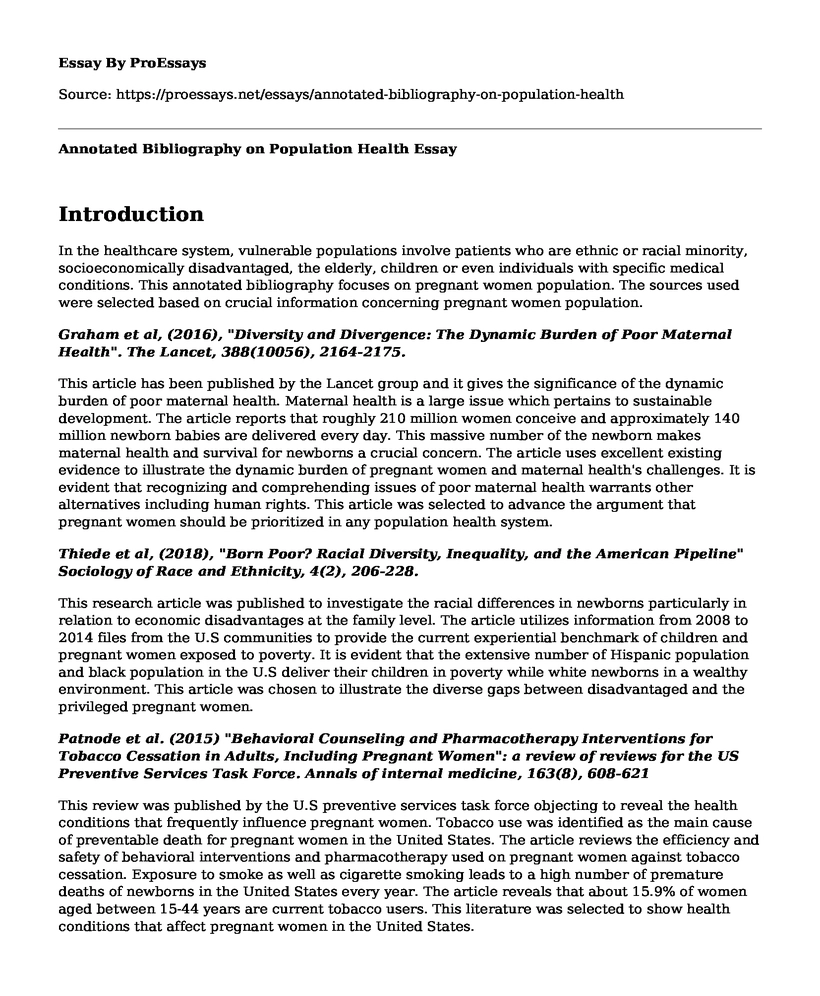Introduction
In the healthcare system, vulnerable populations involve patients who are ethnic or racial minority, socioeconomically disadvantaged, the elderly, children or even individuals with specific medical conditions. This annotated bibliography focuses on pregnant women population. The sources used were selected based on crucial information concerning pregnant women population.
Graham et al, (2016), "Diversity and Divergence: The Dynamic Burden of Poor Maternal Health". The Lancet, 388(10056), 2164-2175.
This article has been published by the Lancet group and it gives the significance of the dynamic burden of poor maternal health. Maternal health is a large issue which pertains to sustainable development. The article reports that roughly 210 million women conceive and approximately 140 million newborn babies are delivered every day. This massive number of the newborn makes maternal health and survival for newborns a crucial concern. The article uses excellent existing evidence to illustrate the dynamic burden of pregnant women and maternal health's challenges. It is evident that recognizing and comprehending issues of poor maternal health warrants other alternatives including human rights. This article was selected to advance the argument that pregnant women should be prioritized in any population health system.
Thiede et al, (2018), "Born Poor? Racial Diversity, Inequality, and the American Pipeline" Sociology of Race and Ethnicity, 4(2), 206-228.
This research article was published to investigate the racial differences in newborns particularly in relation to economic disadvantages at the family level. The article utilizes information from 2008 to 2014 files from the U.S communities to provide the current experiential benchmark of children and pregnant women exposed to poverty. It is evident that the extensive number of Hispanic population and black population in the U.S deliver their children in poverty while white newborns in a wealthy environment. This article was chosen to illustrate the diverse gaps between disadvantaged and the privileged pregnant women.
Patnode et al. (2015) "Behavioral Counseling and Pharmacotherapy Interventions for Tobacco Cessation in Adults, Including Pregnant Women": a review of reviews for the US Preventive Services Task Force. Annals of internal medicine, 163(8), 608-621
This review was published by the U.S preventive services task force objecting to reveal the health conditions that frequently influence pregnant women. Tobacco use was identified as the main cause of preventable death for pregnant women in the United States. The article reviews the efficiency and safety of behavioral interventions and pharmacotherapy used on pregnant women against tobacco cessation. Exposure to smoke as well as cigarette smoking leads to a high number of premature deaths of newborns in the United States every year. The article reveals that about 15.9% of women aged between 15-44 years are current tobacco users. This literature was selected to show health conditions that affect pregnant women in the United States.
De Andrade et al. (2015), "Social Determinants of Health, Universal Health Coverage, And Sustainable Development": case studies from Latin American countries. The Lancet, 385(9975), 1343-1351.
This research article describes numerous intrinsically linked determinants of health and the availability of diseases. The key determinants of health involve education, housing, employment social and economic status as well as physical and environmental exposures. The above-mentioned parameters network cumulatively to influence health and illness burden of pregnant women and other vulnerable populations. These factors, in addition, establish health inequities and differences within and across nations. This article was chosen to advance the argument that main determinants of health have a massive influence on both pregnant women and newborns.
Koblinsky et al. (2016), "Quality Maternity Care for Every Woman, Everywhere: A Call to Action". The Lancet, 388(10057), 2307-2320.
This article is cognizant of the fact that to improve maternal care requires various activities that ensure quality maternal health for all girls and women as well as guaranteeing access to health care for various vulnerable populations. The article examines processes and actions that can be used to achieve the overall goal of reducing maternal deaths while improving the quality of care for pregnant women. A call for collaboration to prioritize women and girls improves health securities and guarantees prosperous future for the newborn and pregnant women. This literature was chosen to justify that the current health population system is efficient and equitable for pregnant women.
Cite this page
Annotated Bibliography on Population Health. (2022, Jun 05). Retrieved from https://proessays.net/essays/annotated-bibliography-on-population-health
If you are the original author of this essay and no longer wish to have it published on the ProEssays website, please click below to request its removal:
- Application of the Total Rewards Approach in Public Healthcare Sector
- Obesity and Diabetes Research Paper Example
- Essay Sample on Genetic Tests for Cancer Risk Genes
- Essay Sample on the Management of Type Two Diabetes
- Essay Sample on the Benefits of Community Public Health Officers
- Essay on T'Pol's Struggle with Pa'nar Syndrome: A Vulcan Taboo
- Definitional Difference between "Brain" and "Mind" - Free Report







